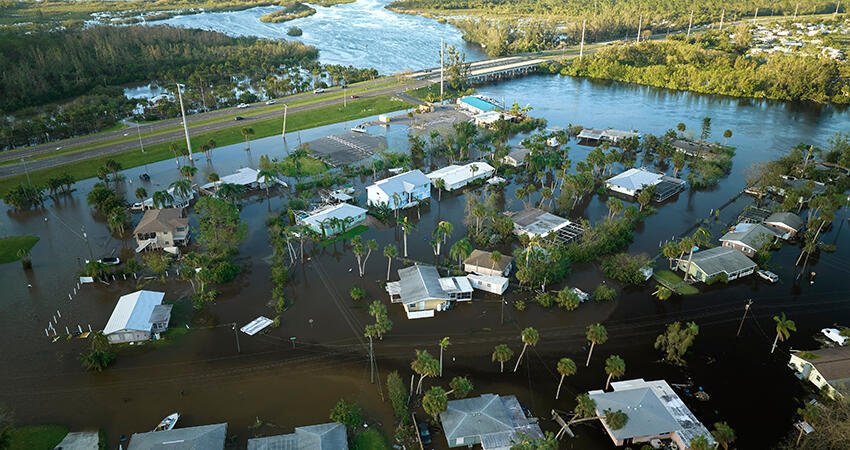
(Bilanol/Shutterstock)
Neglecting Public Housing Leaves Families Vulnerable to the Effects of Climate Change
Residents of public housing rely on units for safety and stability (PDF), but the growing capital needs backlog puts these residents at risk. These hazards may increase as the climate changes and residents face more climate-related events that exacerbate unit-quality issues.
Efforts to reduce these risks have begun, but existing funding sources and planning processes can be leveraged by local leaders and housing authorities to ensure all community members are protected.
Public housing and its residents
Public housing is a critical source of stable housing for more than 1 million residents, the majority of whom are people of color, older adults or those with disabilities, and families with children. In 2016, 91 percent of these households were considered very low income (PDF), meaning they earned less than 50 percent of the area median income. Forty-five and 21 percent of households are Black and Latinx (PDF), compared with 31 percent that are white. More than half of heads of households are someone who’s older than 62 and/or disabled, 40 percent of households include a child (PDF), and more than 100,000 youth or young adults lead their households.
Discriminatory policies and disinvestment led to the displacement of Black families and the placement of public housing properties in isolated neighborhoods (PDF) with few resources and opportunities. Disinvestment in public housing over time resulted in property deterioration and a large capital needs backlog.
Climate risk to units and families
In addition to the threats of deterioration and disinvestment, residents are at risk of climate-related hazards that are likely to worsen as global surface temperatures warm. In some regions of the country, as much as 17 percent of units are located in 100- or 500-year floodplains (PDF).
Floods have already damaged units in communities nationwide, displacing families or worsening unit conditions and increasing risk of mold and other complications. These effects reduce the number of available public housing units, increasing wait times and rent costs.
Climate change will also cause more-extreme heatwaves, which can be deadly for residents without access to air conditioning. Public housing agencies aren’t federally mandated to provide air conditioning, even in places that are already very hot, and residents have already died during record-breaking heat events. New research shows that public housing residents are also at disproportionate risk of exposure to air pollution, which puts them at risk for adverse health outcomes, including asthma and other respiratory ailments. Changes in climate may also worsen air quality.
Climate change will affect all communities, but it’ll be worse for communities with fewer social and economic resources to weather the storms. Residents of public housing are socially vulnerable, meaning they’re more likely to experience the negative impacts of climate-related hazards because they don’t have access to these resources. The poor quality of many units only exacerbates the risk of adverse impacts. Additionally, research shows the voice of public housing residents is typically left out of disaster recovery decisionmaking and that disaster recovery may lead to removal or reduction of public housing units and their residents.
How communities are addressing these risks
Recent coverage of these issues and the dire condition of public housing units has led to some federal funding to support renovation and retrofitting. In 2022, the Biden administration updated the federal Climate Action Plan and passed federal funding to retrofit units (PDF). Communities nationwide are using these programs and other creative funding sources to protect public housing and its residents. Here are a few examples that can inform efforts in other localities:
- Innovative flood mitigation in New York City Housing Authority (NYCHA)
Increasingly heavy downpours can cause mobility challenges for NYCHA residents that last for weeks. Officials plan to take outdoor basketball courts, which often already fill with water during storms, and lower them so they will hold up to 300,000 gallons of water. These projects will be supported in part by Federal Emergency Management Agency flood resiliency grants. - A sustainability agenda in Seattle
The Seattle Housing Authority developed a plan for 2020–25 (PDF) that includes key features to reduce its carbon footprint and improve building performance, resilience, and sustainable business practices. - A retrofit pilot program in Boston
Boston Mayor Michelle Wu created a $20 million retrofit pilot program for public and private multifamily housing aimed at improving energy efficiency while allowing residents to remain in their homes during renovations. The fund uses remaining American Rescue Plan Act funding. This will not only reduce the carbon footprint of public housing but may also improve unit performance during extreme weather.
Climate risks to residents of public housing will worsen if public housing agencies and local governments don’t take steps to address climate change and its effects. Communities can apply the lessons above to ensure the worse of these effects aren’t felt by their most vulnerable residents.


